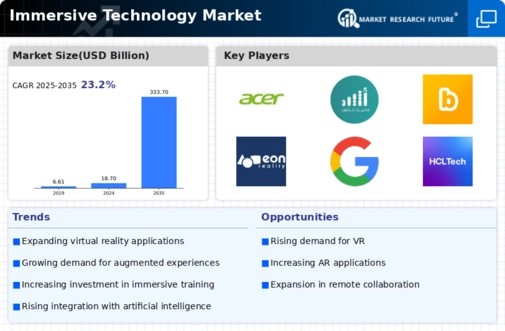Market Share
Immersive Technology Market Share Analysis
In the Immersive Technology sector, VR and AR are becoming more popular in gaming and entertainment. VR gaming immerses players in virtual worlds and is interactive. In mobile games, AR overlays the real environment.
VR and AR are creating virtual learning environments that engage students in challenging subjects. Immersive technology is also used for medical training, industrial and construction safety training, and tourist and hospitality virtual tours. To increase learning outcomes and training effectiveness, immersive and interactive experiences are driving this trend.
Healthcare is demanding more immersive technologies. VR and AR help manage pain, rehab, and mental wellness. VR can simulate therapeutic sessions or divert patients from discomfort. Overlaying digital information on the patient's real-time perspective helps surgeons. Technology is changing healthcare and expanding patient treatment options.
Immersive technologies are also growing in retail and e-commerce. Augmented reality lets buyers digitally try on clothes, picture furniture arrangement in their houses, and see how things might appear in their surroundings. VR stores let users browse merchandise and make educated purchases. This trend aims to connect online and physical purchasing, customize and streamline experiences, and boost consumer happiness.
Additionally, immersive technologies are being used in corporate applications. To create dynamic and memorable brand experiences, marketers and advertisers use immersive technology. The promise for increased productivity, cost savings, and consumer engagement via immersive technology drives this trend.
Increased attempts are being made to make Immersive Technology more accessible and user-friendly. Making VR and AR gadgets cheaper and lighter improves comfort and usefulness. Software developers create simple interfaces and apps that need little technical knowledge. To expand immersive technology usage across populations and sectors, this trend is driven.
Integration of immersive technologies with other new technologies is also expanding. VR + AI can build smarter, more interactive virtual experiences. AR-IoT integration can provide smart augmented reality experiences in home automation and industrial maintenance. Utilizing technology synergies to create more immersive and engaging experiences drives this trend.












Leave a Comment